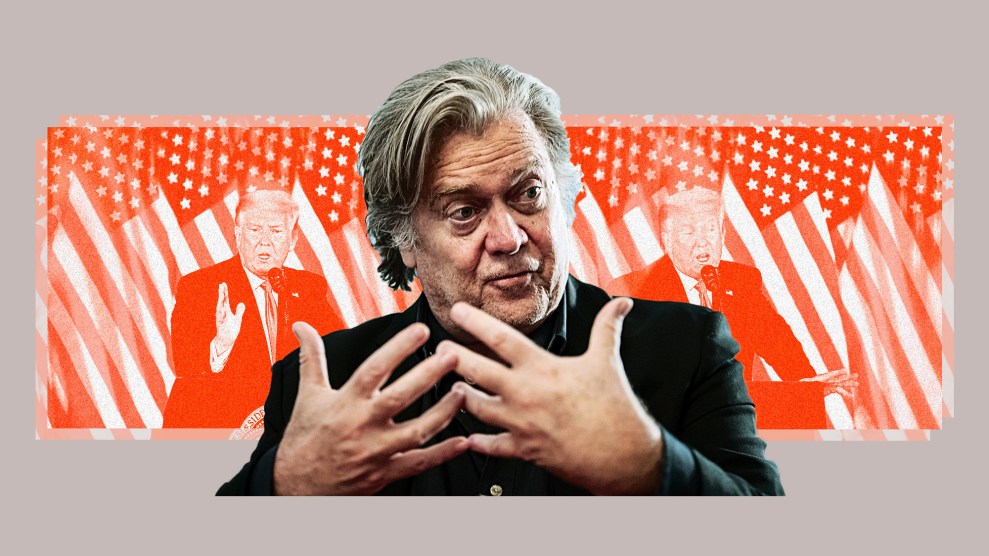In May, during an Aspen Institute conference, House Speaker Nancy Pelosi told the audience, “I want the Republican Party to take back the party, take it back to where you were when you cared about a woman’s right to choose, you cared about the environment…This country needs a strong Republican Party. And we do. Not a cult. But a strong Republican Party.” Her comments echoed a sentiment that Joe Biden had expressed during the 2020 campaign: If Donald Trump were out of the White House, the GOP would return to normal and be amenable to forging deals and legislative compromises.
Both Pelosi and Biden have bolstered the notion that the current GOP, with its cultlike embrace of Trump and his Big Lie, and its acceptance of the fringiest players, is a break from the past. But was the GOP’s complete surrender to Trumpism an aberration? Or was the party long sliding toward this point? About a year ago, I set out to explore the history of the Republican Party, with this question in mind. What I found was not an exception, but a pattern. Since the 1950s, the GOP has repeatedly mined fear, resentment, prejudice, and grievance and played to extremist forces so the party could win elections. Trump assembling white supremacists, neo-Nazis, Christian nationalists, QAnoners, and others who formed a violent terrorist mob on January 6 is only the most flagrant manifestation of the tried-and-true GOP tactic to court kooks and bigots. It’s an ugly and shameful history that has led the Party of Lincoln, founded in 1854 to oppose the extension of slavery, to the Party of Trump, which capitalizes on racism and assaults democracy.
In my book American Psychosis: A Historical Investigation of How the Republican Party Went Crazy, I lay out this sordid history in great detail. But even a highlight reel makes it clear that the GOP has bowed to, depended on, and promoted far-right extremists and conspiracists for the past 70 years. Trumpism is the continuation, not a new version, of Republican politics.
The General and the Scoundrel
Dwight D. Eisenhower surrendered to Joe McCarthy on a train.
In October 1952, Ike, the heroic World War II general who nabbed the GOP presidential nomination running as a moderate, was campaigning in Wisconsin with the nation’s No. 1 Red-baiter. Two years earlier, Wisconsin’s junior senator had claimed he possessed a list of 205 Communist Party members “working and shaping policy” in the State Department. That was a lie. But McCarthy helped trigger a national panic over supposed commie infiltration and became a powerhouse within the GOP. His reckless conspiracy-mongering reached a new height in 1951 when he accused the Truman administration of scheming to deliver the nation “to disaster” with an “immense” conspiracy. And McCarthy fingered the ultimate villain: George Marshall, the secretary of defense who had helped create the postwar recovery program for Europe known as the Marshall Plan. McCarthy alleged that Marshall was deliberately weakening the United States so it would fall to the Soviet Union.
This conspiratorial nuttery—designed to prey on Cold War paranoia—struck a chord with millions of voters, and McCarthy was lionized at the GOP convention the following year. Eisenhower believed McCarthy to be a dangerous demagogue and fabricator, and he especially seethed at the attack on his friend Marshall. Yet in the 1952 campaign, Ike was expected to campaign side by side with—and legitimize—this scoundrel who was up for reelection.
Eisenhower considered a public strike against McCarthy and had asked a speechwriter to add a short riff to a major speech in Wisconsin that would defend Marshall and assail McCarthy’s attack on him.
When top Republicans on the campaign train caught wind of Ike’s intention, they became alarmed. McCarthy had millions of supporters. Many were Catholic, which gave the GOP an opportunity to break the Democrats’ hold on the Catholic vote. Plus, the party might need Wisconsin to win the election. A senior Eisenhower adviser explained this political calculus to Ike. “Are you telling me this paragraph should come out?” Eisenhower asked. Yes, the aide replied. “Take it out,” Eisenhower commanded.
That night, in his speech, Eisenhower cautioned against the “spirit of violent vigilantism” in the fight for freedom. But he decried left-wing “contamination” in “virtually every department…of our government” and called for “the right to call a Red a Red.” Rather than assail McCarthyism, he sounded as if he were defending it. The Milwaukee Journal observed, “The general went far toward surrendering ethical and moral principles in a frenzied quest for votes.”
Eisenhower, who decisively won the election, would later regret his decision to cut the anti-McCarthy paragraph. As president, he continued to loathe McCarthy, but refused to directly confront him—though behind the scenes he encouraged criticism of the senator. Eventually, McCarthy’s own excesses did him in, and he was censured by the Senate and lost his power and influence. Eisenhower snickered that McCarthyism was now “McCarthywasm.”
But Ike was wrong; others in his party, including his vice president, Richard Nixon, would keep Red-scare hysteria alive. The demagogic promotion of unhinged paranoia had become baked into the GOP’s DNA.
The Senator and the Birchers
On March 27, 1961, Sen. Barry Goldwater, the libertarian Arizona Republican and conservative hero, wrote a letter to William F. Buckley Jr., the 35-year-old editor of the National Review. Goldwater wanted Buckley to go easy on the far-right kooks gaining sway within the GOP, in particular the John Birch Society. Founded three years earlier by former candy manufacturer Robert Welch, a loon who believed the commies had fully infiltrated every nook and cranny of American life, the society had quickly become a key force on the right and a source of volunteers, organizers, and donors for conservative Republican candidates. Some Republicans feared that these extremists, with their bonkers conspiracy theories, could discredit the party, a concern that intensified when the Chicago Daily News revealed Welch had claimed that Eisenhower was “a dedicated, conscious agent of the Communist conspiracy.”
In his letter to Buckley, Goldwater wrote, “Let’s keep together on this John Birch thing and I would suggest as of now that we allow it to go along for awhile before we take any other steps.” Mr. Conservative was asking the guru of the rising right to abide Welch’s conspiratorial nonsense, even permit it to spread. And in public, Goldwater was supportive of Welch’s group, noting he was “impressed by the type of people in it.”
In January 1962, Buckley and other conservative luminaries met with Goldwater at a Florida hotel and further discussed what to do about the Birchers. Goldwater insisted the group contained both “kooks” and decent conservatives and was opposed to slamming it. Others in the room wanted to excommunicate the Birchers from the conservative movement. They cooked up a compromise: denounce Welch but not the society. A month later, the National Review blasted Welch’s views as “far removed from common sense.” But the magazine hailed the society for being the home of “dedicated anti-Communists.” Two weeks after that, Goldwater declared that Welch should resign.
This joint Goldwater-Buckley effort to delegitimize Welch while praising the society was disingenuous. The fundamental mission of the Birchers was to promote crazy McCarthyistic conspiracy theories (Fluoridation was a Red plot!). They were allowing this lunacy to spread, even encouraging it.
When Goldwater ran for president in 1964, Birchers enthusiastically donated and volunteered for him. A big boost came from Phyllis Schlafly, a secret member of the society, who had written a book extolling Goldwater. Her slim volume became a key component of the Goldwater campaign. With all this assistance from Birchers and other far-right extremists, Goldwater secured the nomination, and, in his acceptance speech at the GOP convention, famously thundered that “extremism in the defense of liberty is no vice.”
President Lyndon Johnson used Goldwater’s embrace of extremism to thrash him in the general election, and pundits claimed the GOP and the conservative movement were all but finished. But Goldwater had brought a flood of radicals into the Republican Party—and they weren’t leaving.

The Southern Strategy
In 1968, Nixon had a problem, actually two: George Wallace and Ronald Reagan. Having lost the 1960 presidential race, Nixon was again trying to capture the White House. Nixon worried that Wallace, the segregationist and former Democratic governor of Alabama running as a third-party candidate, would be a magnet for conservative voters and deny him the electoral votes Goldwater had won in the South. Even more immediately, Nixon feared that Reagan, the onetime B-movie star who had won the California governorship in 1966 by exploiting white backlash to the civil rights movement and social unrest, might swipe the nomination from him.
This led him into the arms of white supremacists. At a May gathering of Southern Republican officials, Nixon pandered, saying he opposed forcing the pace of integration, especially busing to redress school segregation, and favored conservative Supreme Court justices (who would be skeptical of initiatives to advance the rights of Black Americans). He asked the group how to deal with the Wallace threat. You need Strom Thurmond, the arch-segregationist senator from South Carolina, he was told.
The next day, Nixon met with Thurmond and repeated his song-and-dance routine. Thurmond signed on. He would help Nixon campaign against Wallace and keep Southern delegates from stampeding toward Reagan at the GOP convention.
In subsequent weeks, Nixon contemplated how best to capitalize on racism. He told his chief of staff, H.R. Haldeman, that Nixon could do well with “ethnics,” naming “Irish, Ital, Pole, Mex,” because “they’re afraid of Negroes,” and that he intended to ignore the “Jewish and Negro vote” and “go for” Catholic and Wallace voters. At the convention, Nixon instructed his campaign manager, John Mitchell, to tell Southern party leaders that he would choose a running mate acceptable to the South and would “lay off pro-Negro crap.” This was the birth of Nixon’s Southern strategy.
With these assurances—and with Thurmond leaning on the Southern bosses—Nixon blocked Reagan and won the nomination. He chose Maryland Gov. Spiro Agnew, an experienced race-baiter, as his running mate. Nixon proclaimed, “I won the nomination without paying any price or making any deals.” That was false. He had won the nomination battle by kneeling before the segregationists and adopting racism as a key ingredient in the GOP’S recipe for electoral success.
Reagan’s Allies of Hate
Reagan eventually got his turn. After being nominated at the GOP’s presidential convention in July 1980, his first campaign stop was in Philadelphia, Mississippi—where 16 years earlier the Ku Klux Klan had murdered three civil rights workers. At a county fair, he gave a speech declaring, “I believe in states’ rights”—the mantra of Southern segregationists. It was an unambiguous sign that Reagan would continue the Republican practice of appealing to racists. A couple weeks later, Reagan deepened his alliance with another extremist constituency.
The Christian right had recently emerged as a political force, particularly after TV preacher Jerry Falwell founded the Moral Majority in 1979. Falwell had a long history of hatred. In a 1958 sermon, he had railed against integration. More recently, he had waged a crusade to demonize homosexuals, who he contended literally threatened the existence of the United States. Gay people, he said in 1977, would “kill you as quick as look at you.”
Throughout the campaign, Reagan courted the new religious right. At the end of August 1980, he appeared at a Dallas gathering of thousands of Christian fundamentalists, including 4,500 pastors, which was underwritten partly by oil tycoon Nelson Bunker Hunt, an ardent Bircher. The speakers’ lineup was a who’s who of the far right: Falwell, Schlafly, televangelist Pat Robertson, Tim LaHaye (a popular evangelist who had been a John Birch Society member), and others. Christian broadcaster D. James Kennedy warned the faithful that “1980 could be America’s last free election.” Speakers urged pastors to join a voter registration drive, with an obvious goal: elect Reagan.
Reagan advisers Michael Deaver and Edwin Meese fretted over what the fiery Pastor James Robison, an organizer of the event, would say when he spoke just prior to Reagan’s address. They urged Reagan to wait offstage. But the candidate strode onto the stage and sat behind Robison. “There is no possible way that you can separate God from government and have a successful government,” Robison thundered. He blasted liberals, homosexuals, and communists, lumping them all together into one giant threat to American families. “We’ll either have a Hitler-type takeover, or Soviet dominion, or God is going to take over this country.” The Christian right had adopted the inflammatory conspiratorial paranoia of McCarthyism, adding liberals and gays to the list of subversive internal threats to the nation. Throughout Robison’s speech, Reagan nodded and applauded, and when it was his turn to speak, he threw the crowd a gigantic rhetorical wink: “I know that you can’t endorse me, but…I want you to know that I endorse you.” The crowd roared.
During the campaign, President Jimmy Carter tried to call attention to Reagan’s ties to extremists. But the political press accused Carter of being mean and divisive. Reagan’s courtship of Southern racists and religious fanatics never became a major issue, and he beat Carter decisively. “Reagan would have lost the election by one percentage point without the help of the Moral Majority,” pollster Lou Harris observed. After the election, Falwell entered a victory rally at his Liberty Baptist College, while “Hail to the Chief” played in the background.
Satan’s Useful Idiot
On September 11, 1992, President George H.W. Bush appeared before the Christian Coalition and lauded founder Pat Robertson for “all the work you’re doing to restore the spiritual foundation of this nation”—even though the previous year, Robertson had alleged Bush was part of a Satanic plot. Literally.
Robertson, head of the Christian Broadcasting Network, had competed for the Republican presidential nomination in 1988. During that race, Robertson encouraged his fanatic followers to burrow into state party apparatuses, which they did, gaining control of local party mechanisms in some states, and he promoted a variety of conspiratorial notions, accusing Bush of being allied with a diabolical cabal of international bankers. After Bush triumphed in the primary contest, the GOP handed Robertson a primetime speaking slot at its convention.
The GOP’s embrace of Robertson became a bear hug after he formed the Christian Coalition in early 1990. Though Christian Coalition candidates challenged Republican regulars in local races, GOP bigwigs quickly came to appreciate its organizing might and strategically ignored the inconvenient fact that its leader was a crackpot. Top Republicans, including Vice President Dan Quayle, flocked to the organization’s first conference in 1991 to hail Robertson and his troops.
There, Robertson advanced the far-right trope that America was being annihilated from within, claiming “elites” were trying “to destroy the very society from which they drew their nurture.” He added, “There will be Satanic forces…We are not going to be coming up just against human beings to beat them in elections. We’re going to be coming up against spiritual warfare.” According to Robertson, the political foes of the Christian Coalition and the Republicans were directly in cahoots with the devil.
Two months earlier, Robertson had published a book, called The New World Order, that merged some of the battiest conspiracy theories of the ages. He claimed that secret societies and schemers—occultists, communists, and elites—had for centuries conspired to lock the world in a godless, collectivist dictatorship. The Federal Reserve, J.P. Morgan, the Rockefellers, the Council on Foreign Relations, the United Nations, Henry Kissinger—they were all in on it. So, too, were “European bankers” and the Rothschild family (long a target of antisemitic conspiracy theories). George H.W. Bush, he asserted, had “unwittingly” carried out “the mission…of a tightly knit cabal whose goal is nothing less than a new order for the human race under the domination of Lucifer and his followers.”
George Bush, Satanic dupe—that was Robertson’s claim. The Wall Street Journal called his book a “compendium of the lunatic fringe’s greatest hits.” Yet in search of votes, Bush and the GOP validated this antisemitic and paranoid zealot and signaled to his followers and the world that he and his ideas were worth heeding.
Robertson’s troops could not save Bush when he ran for reelection. But the Christian Coalition would become further integrated into the GOP and help Newt Gingrich and the Republicans gain control of the House in 1994. Six years later, Robertson and his group would rescue Texas Gov. George W. Bush when Sen. John McCain threatened to defeat him in the Republican presidential primary. W. welcomed the assistance of the nut who had pegged his dad as Satan’s useful idiot.
Joining the Tea Party
In the fall of 2009, a House Republican backbencher summoned conservative activists to the Capitol for a protest and ended up fusing the GOP to a new manifestation of far-right extremism.
Earlier in the year, the Tea Party movement had emerged in response to Barack Obama’s election as president. Nominally, its adherents were against his stimulus measure to buoy the economy after the calamitous housing and banking crash. But the Tea Party was shot full of paranoia, racism, and rage. At rallies, attendees waved Confederate flags and claimed Obama was a secret Muslim born in Kenya who was in league with shadowy elites and purposefully trying to destroy the nation so he could impose a totalitarian regime. Tea Partiers, led by Sarah Palin, the defeated Republican vice presidential candidate, falsely claimed Obama’s health care reform bill would set up “death panels” that would determine whether the elderly and the ill should be allowed to perish. (PolitiFact branded this the “Lie of the Year.”) Republican officeholders echoed this charge. They also legitimized Fox News host Glenn Beck, an unofficial Tea Party leader who suggested Obama was a “full-fledged Marxist” who hated white people, was setting up concentration camps for his political foes, and was creating a “fascist” state. Beck was peddling Bircher-like apocalyptic paranoia, and GOP stalwarts were happy to go on his show and help him sell it.
Minnesota Rep. Michele Bachmann, another leader of this unhinged movement, suggested the Obama administration was using census information to establish internment camps, and in early November 2009, she urged Tea Partiers to protest the health care bill at the Capitol. Thousands showed up. They carried signs depicting Obama as Sambo. One placard read “Obama Takes His Orders From the Rothschilds.” Another equated Obamacare with a Holocaust death camp. At the mention of Democrats’ health care plan, the Tea Partiers shouted, “Nazis! Nazis!”
Yet this crowd was welcomed by the top leadership of the GOP. Present were House Republican leader John Boehner, Reps. Eric Cantor and Mike Pence, and other House Republicans. Boehner, who calculated he could ride Tea Party ire into the House majority and the speakership, affirmed the crowd’s fear and paranoia, proclaiming the health care bill “the greatest threat to freedom I have ever seen.”
The GOP failed to block Obamacare, but the Republican Party reinforced and utilized the anger of the movement to seize control of the House in 2010. And Boehner did become speaker—only to find that the new Tea Party–allied Republicans in the House were far-right fanatics who blocked his efforts at cut-the-difference dealmaking on deficit reduction and immigration reform. Five years later, Boehner retired, just steps ahead of a conservative mutiny against him. He had been devoured by the extremists he had exploited to attain power. Boehner and other Republicans had emboldened a nativistic and tribalistic right-wing force that would soon provide a political base for Trump’s jingoistic, racist, and demagogic campaign.
There’s a well-established record. For more than 70 years, the Republican Party has stoked animus and conspiracies, often capitalizing on unfounded apprehension about internal enemies subverting the nation. In the 1950s, the foe was Reds. In the 1960s (and beyond), it was Black people demanding social justice and societal change. In the 1970s, the New Right and the religious right claimed liberals and Democrats (and gays!) were plotting to destroy the nation. Tea Partiers asserted Obama headed a sinister cabal bent on turning the United States into a socialist hellhole. Trump and his devotees say the same about today’s Democrats.
From McCarthyism to the Southern strategy to the New Right to the Tea Party—the GOP told Americans they were being victimized and that their nation was being sabotaged by their fellow citizens. The Republican Party encouraged Americans to believe the worst, and it affirmed the worst beliefs held by Americans. It operated a feedback loop that caused and reinforced animosity. It bred extremism; it cynically profited off extremism.
There is a great body of academic literature exploring why people believe conspiracy theories, hold fast to false premises, and are susceptible to tribalism and drawn to authoritarians. In 1970, sociologists Seymour Martin Lipset and Earl Raab wrote, “Right-wing extremist movements in America have all risen against the background of economic and social changes which have resulted in the displacement of some population groups from former positions of dominance.” Four decades later, political scientists Christopher S. Parker and Matt A. Barreto concluded, “People are driven to support the Tea Party from the anxiety they feel as they perceive the America they know, the country they love, slipping away, threatened by the rapidly changing face of what they believe is the ‘real’ America: a heterosexual, Christian, middle-class, (mostly) male, white country.” In an analysis of Trump’s 2016 victory, political scientists John Sides, Michael Tesler, and Lynn Vavreck reached an identical conclusion: “He capitalized on an existing reservoir of discontent about a changing American society and culture.”
The GOP hasn’t been all extremism, all the time. Goldwater, late in his career, railed against the religious right and supported reproductive rights. As president, Nixon challenged assorted Cold War assumptions and created the Environmental Protection Agency. George W. Bush warned against anti-Muslim bigotry following 9/11. But since at least the 1950s, the party has consistently boosted extremism, prejudice, paranoia, and rage. Sometimes this has led to the GOP prevailing in political battles. In other instances, voters have beaten back this cynical gambit.
This dark side of the Republican Party has often been obfuscated, allowing Biden, Pelosi, and others to suggest there was once a day when the GOP was an honorable entity. Yet the history is undeniable: The party has consistently sought to exploit the worst of America and foment hate and suspicion. Trump didn’t invent this malevolence. He merely turned it into the party’s brand.
Adapted from David Corn’s American Psychosis: A Historical Investigation of How the Republican Party Went Crazy, which will be published by Twelve in September.














